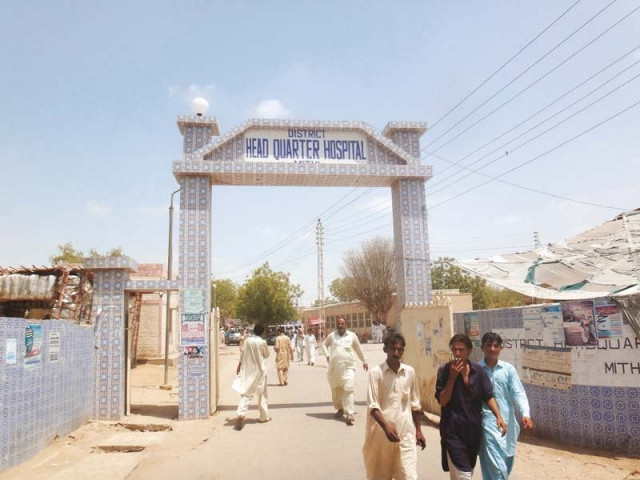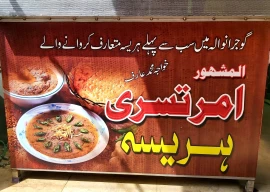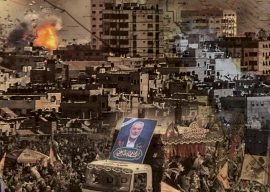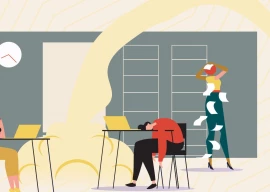
Father of eight Aarab Kapri braved a gruelling 75-kilometre journey from Wangi village to the civil hospital for his newborn child suffering from severe malnutrition. “The hospital is a slaughter house. No one cares now that the media has turned its focus to other issues,” he complains. Kapri says his wife is anemic and gave birth to an underweight boy five days ago. Soon, the condition of both the mother and child deteriorated, compelling Kapri to rush them to the hospital. A taxi ride to the hospital costs Rs5,000, an amount near impossible to cough up for a family that has braved four consecutive droughts.
Read: Water crisis: High and dry
The grief is apparent in the eyes of Kapri’s wife Ameeran, who says she can see her son slowly dying. “Who should I complain to: God or my fortune? No one is here to listen to our miseries,” she says, adding that doctors have asked them to purchase medicines from outside the hospital because the ones available there are substandard. They also asked them to get pathological test done from somewhere else as they do not trust the results of the hospital lab.

Female patients wait for their turn at the outpatient department. PHOTOS : KHALID KUMBHAR

A young man suffering from malaria receives medical assistance. PHOTOS : KHALID KUMBHAR
According to an attendant at civil hospital Kheto Mal Bheel, the administration was not providing food supplements to children admitted there, even though it was receiving provisions from Unicef. He added the hospital puts up a façade in front of the media, but the situation is completely different beyond the camera.
Read: Earth's groundwater being drained at rapid rate: study
Moreover, social activist Mama Vishan Thari, known as the ‘Edhi of Thar’, adds, pregnant and lactating mothers are suffering from severe anemia. Vishan says he has seen pregnant women with hemoglobin levels as low as 2mg and 4mg, which can be fatal. He laments the lack of health awareness, which in turn results in no antenatal or postnatal care. Furthermore, no attention is paid to the facilities available at the hospital, Vishan says. Most health facilities in the desert shut down at 2:00pm. He also questions how poor people can be expected to purchase medicines and pay for tests outside the hospital. “Officials in all the departments think of themselves as lords rather than public servants,” he says.

A men takes care of his child while his wife is admitted at the Mithi Civil Hospital PHOTOS : KHALID KUMBHAR

Family members wait at the hospital. PHOTOS : KHALID KUMBHAR
DHO Dr Jaleel Bhurgri, on the other hand, insists a number of facilities have been improved at Mithi Civil Hospital. “The nursery ward has been developed, the number of incubators was increased from four to 13 and more doctors have been hired.” However, he says, 50% posts for lower-level staff are still vacant. Dr Bhurgri admits there was no sanctioned post for a nutritionist either. Even the hospital ambulance is out of order, he says. Despite having admitted to a number of things, the DHO categorically rules out the alleged practice of doctors prescribing medicines and tests from outside the hospital.

A child with his younger sister in the hospital’s corridor. PHOTOS : KHALID KUMBHAR
Dr Abdul Aziz Kumbhar says the government has a policy whereby it sanctions one dispensary for a population of 10,000. This, however, is an ineffective policy for a scattered population such as Tharparkar’s. People do not have access to timely medical attention in case of emergencies and many often die by the time they get to a hospital, adds Dr Kumbhar. He stresses that the government needs to revise its policy and sanction a medical facility for every 5,000 people in order to save precious human lives.
Read: Water worries: Tank braces for a dry summer
Tharparkar’s woes all arise out of water, or rather the lack of it. Researcher Ali Akbar Rahimoon talks about the three angles of water in Tharparkar: quality, scarcity and access, and women fetching water during pregnancy. The major source is rainwater, harvested either directly or from the ground by digging wells and tube wells. The depth of wells ranges from 20 feet to 350 feet and many have to cover considerable distances on foot to fetch water for their homes. Rahimoon says 50% of Thar’s underground water contains total dissolved solids of more than 5,000 ppm (parts per million); there is an excess of fluoride and nitrate, which makes the water unfit for human consumption.

Attendants of patients queue to get food assistance from Bahria Dastarkhwan, located near Mithi Civil Hospital. PHOTOS : KHALID KUMBHAR

A newborn baby lies in an incubator at the children’s ward of Mithi Civil Hospital. PHOTOS : KHALID KUMBHAR
To add to this, Rahimoon says, May to July is the ‘stress period’ during which wells dry up completely or the discharge rate drops considerably, because of which concentration of salts increases considerably. In Ramazan, women, children and the old are especially at risk because of lower immunity.
Abdul Haleem Soomro is a social activist and freelance journalist
Published in The Express Tribune, Sunday Magazine, June 28th, 2015.


















COMMENTS
Comments are moderated and generally will be posted if they are on-topic and not abusive.
For more information, please see our Comments FAQ